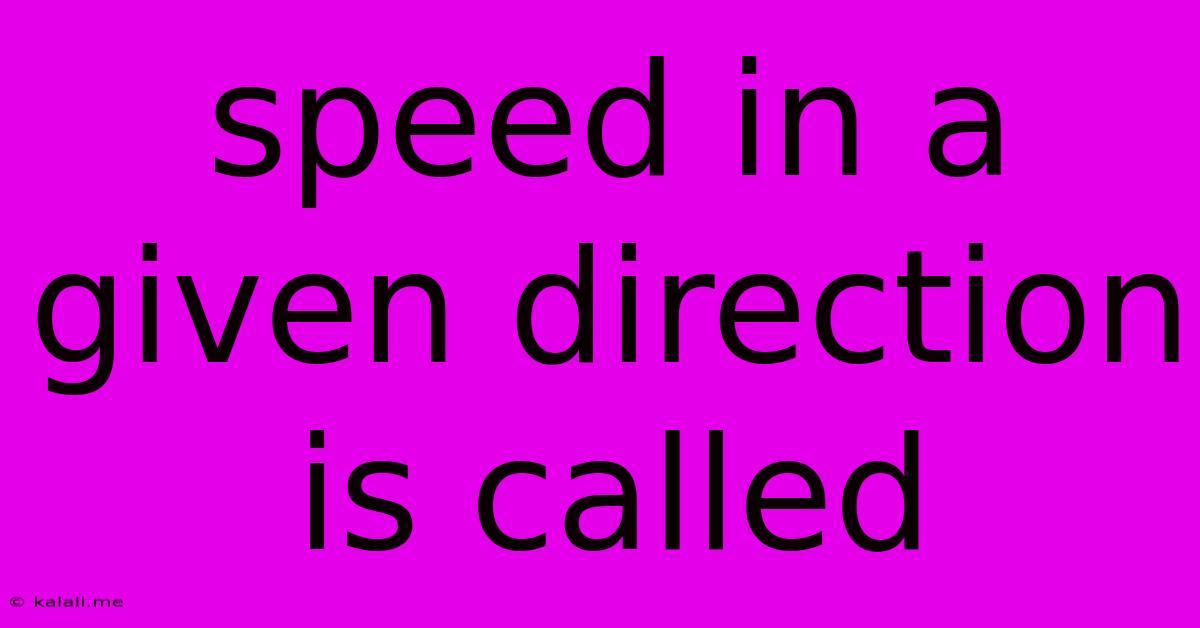Speed In A Given Direction Is Called
Kalali
Jun 15, 2025 · 3 min read

Table of Contents
Speed in a Given Direction is Called Velocity: Understanding the Difference
What do we call speed in a given direction? The answer is velocity. While seemingly simple, understanding the difference between speed and velocity is crucial in physics and many other fields. This article will delve into the distinction between these two concepts, exploring their definitions, units, and practical applications.
Speed is a scalar quantity that refers to how fast an object is moving. It only tells us the magnitude (or size) of the rate of change of position. For example, a car traveling at 60 mph is moving at a speed of 60 mph. This doesn't tell us where the car is going, only how quickly its position is changing.
Velocity, on the other hand, is a vector quantity. This means it has both magnitude (speed) and direction. The same car traveling at 60 mph north has a velocity of 60 mph north. The direction is an essential component of velocity. A change in either speed or direction, or both, results in a change in velocity.
Key Differences Summarized:
| Feature | Speed | Velocity |
|---|---|---|
| Type | Scalar | Vector |
| Magnitude | Yes | Yes |
| Direction | No | Yes |
| Units | m/s, km/h, mph, etc. | m/s, km/h, mph, etc. (with direction) |
| Example | 50 km/h | 50 km/h North |
Understanding Vector Nature of Velocity
The vector nature of velocity means it can be represented graphically using arrows. The length of the arrow represents the magnitude (speed), and the direction of the arrow indicates the direction of motion. This visual representation is particularly useful when dealing with multiple velocities or changes in velocity. For instance, understanding the resultant velocity of a boat crossing a river requires considering both the boat's velocity and the river's current velocity as vectors.
Applications of Velocity
The concept of velocity has numerous applications across various fields. In:
- Physics: Calculating projectile motion, understanding orbital mechanics, and analyzing collisions all rely heavily on the principles of velocity.
- Engineering: Designing vehicles, aircraft, and spacecraft necessitates precise calculations involving velocity and its changes.
- Meteorology: Predicting weather patterns involves analyzing wind velocity and its impact on atmospheric conditions.
- Navigation: GPS systems utilize velocity data to track and predict the movement of objects.
Constant Velocity vs. Changing Velocity
It's important to note the difference between constant velocity and changing velocity. Constant velocity implies both constant speed and constant direction. Any change in either speed or direction (or both) results in a change in velocity, even if the speed remains the same. Think of a car going around a circular track at a constant speed – its velocity is constantly changing because its direction is constantly changing. This change in velocity is what we call acceleration.
In conclusion, while speed tells us how fast something is moving, velocity provides a complete description of motion by specifying both the rate of change of position (speed) and the direction of that change. This distinction is fundamental to a thorough understanding of motion and its applications in various scientific and engineering disciplines.
Latest Posts
Latest Posts
-
Bank Account Closing Letter Word Format
Jun 15, 2025
-
The First Five Multiples Of 9
Jun 15, 2025
-
What Is The Factor Of 112
Jun 15, 2025
-
Difference Between Electron Affinity And Electronegativity
Jun 15, 2025
-
Which Of The Following Is Not A Property Of Metal
Jun 15, 2025
Related Post
Thank you for visiting our website which covers about Speed In A Given Direction Is Called . We hope the information provided has been useful to you. Feel free to contact us if you have any questions or need further assistance. See you next time and don't miss to bookmark.